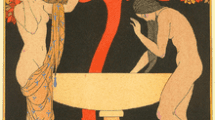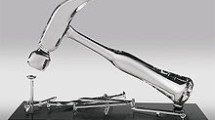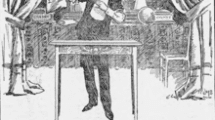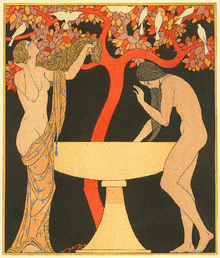Fake newspaper article series published by New York newspaper ‘The Sun’ in 1835
The “Great Moon Hoax”, also known as the “Great Moon Hoax of 1835”, was a series of six articles published in The Sun, a New York newspaper, beginning on August 25, 1835, about the supposed discovery of life and even civilization on the Moon. The discoveries were falsely attributed to Sir John Herschel, one of the best-known astronomers of that time.[1]
The story was advertised on August 21, 1835, as an upcoming feature allegedly reprinted from The Edinburgh Courant.[2] The first in a series of six was published four days later on August 25.
Article[edit]
Portrait of a man-bat (“Vespertilio-homo”), from an edition of the Moon series published in Naples
The headline read:
GREAT ASTRONOMICAL DISCOVERIES
LATELY MADE
BY SIR JOHN HERSCHEL, L.L.D. F.R.S. &c.
[From Supplement to the Edinburgh Journal of Science]
The articles described animals on the Moon, including bison, goats, unicorns, bipedal tail-less beavers and bat-like winged humanoids (“Vespertilio-homo”) who built temples. There were trees, oceans and beaches. These discoveries were supposedly made with “an immense telescope of an entirely new principle”.
Vespertilio-homo can be translated from Latin as man-bat, bat-man, or man-bats.[3][4] A reprinted edition of 1836 added a second type named the Vespertiliones or the bat-men.[5] The author of the narrative was ostensibly Dr. Andrew Grant, the travelling companion and amanuensis of Sir John Herschel, but Grant was fictitious.
Eventually, the authors announced that the observations had been terminated by the destruction of the telescope, by means of the Sun causing the lens to act as a “burning glass”, setting fire to the observatory.[6]
Authorship[edit]
Moon Hoax 1859 NY William Gowans, Richard Adams Locke
Authorship of the article has been attributed to Richard Adams Locke (1800–1871),[7][8] a reporter who, in August 1835, was working for The Sun. Locke publicly admitted to being the author in 1840, in a letter to the weekly paper New World.[9] Still, rumours persisted that others were involved. Two other men have been noted in connection with the hoax: Jean-Nicolas Nicollet,[7] a French astronomer travelling in America at the time (though he was in Mississippi, not New York, when the Moon-hoax issues appeared), and Lewis Gaylord Clark, editor of The Knickerbocker, a literary magazine. However, there is no good evidence to indicate that anyone but Locke was the author of the hoax.
Assuming that Richard A. Locke was the author, his intentions were probably, first, to create a sensational story which would increase sales of The Sun, and, second, to ridicule some of the more extravagant astronomical theories that had recently been published. For instance, in 1824, Franz von Paula Gruithuisen, professor of Astronomy at Munich University, had published a paper titled “Discovery of Many Distinct Traces of Lunar Inhabitants, Especially of One of Their Colossal Buildings”. Gruithuisen claimed to have observed various shades of color on the lunar surface, which he correlated with climate and vegetation zones. He also observed lines and geometrical shapes, which he felt indicated the existence of walls, roads, fortifications, and cities.
However, a more direct object of Locke’s satire was Rev. Thomas Dick, who was known as “The Christian Philosopher” after the title of his first book.[10] Dick had computed that the Solar System contained 21,891,974,404,480 (21.9 trillion) inhabitants. In fact, the Moon alone, by his count, would contain 4,200,000,000 inhabitants.[11] His writings were enormously popular in the United States; intellectual Ralph Waldo Emerson was one of his fans.[12]
Reactions[edit]
Great Moon Hoax, Edinburgh Journal of Science, by Lilith de Thierry Freres
According to legend, The Sun’s circulation increased dramatically because of the hoax and remained permanently greater than before, thereby establishing The Sun as a successful paper. However, the degree to which the hoax increased the paper’s circulation has certainly been exaggerated in popular accounts of the event. It was not discovered to be a hoax for several weeks after its publication and, even then, the newspaper did not issue a retraction.[13]
Herschel was initially amused by the hoax, noting that his own real observations could never be as exciting. He later became annoyed when he had to answer questions from people who believed the hoax was serious.
Edgar Allan Poe claimed the story was a plagiarism of his earlier work “The Unparalleled Adventure of One Hans Pfaall”. His editor at the time was Richard Adams Locke. He later published “The Balloon-Hoax” in the same newspaper.[14]
Poe had published his own Moon hoax in late June 1835, two months before the similar Locke Moon hoax, in the Southern Literary Messenger entitled “Hans Phaall – A Tale”, later republished as “The Unparalleled Adventure of One Hans Pfaall”. The story was reprinted in the New York Transcript on September 2–5, 1835, under the headline “Lunar Discoveries, Extraordinary Aerial Voyage by Baron Hans Pfaall”. Poe described a voyage to the Moon in a balloon, in which Pfaall lives for five years on the Moon with lunarians and sends back a lunarian to earth. The Poe Moon hoax was less successful because of the satiric and comical tone of the account. Locke was able to upstage Poe and to steal his thunder. In 1846, Poe would write a biographical sketch of Locke as part of his series “The Literati of New York City” which appeared in Godey’s Lady’s Book.
Nate DiMeo’s historical podcast The Memory Palace dedicated a 2010 episode to the Great Moon Hoax entitled “The Moon in the Sun”.[15]
The hoax inspired a three part musical by composer Matt Dahan as part of his musical radio series Pulp Musicals.[16]
Richard Adams Locke and the Great Moon Hoax are fictionalized in chapter 14 of Félix J. Palma’s 2012 novel “The Map of the Sky”.
See also[edit]
References[edit]
^ Vida, István Kornél (2012). “The “Great Moon Hoax” of 1835″. Hungarian Journal of English and American Studies. 18 (1/2): 431–441. JSTOR 43488485.
^ Maliszewski, Paul. “Paper Moon”, Wilson Quarterly. Winter 2005. p. 26.
^ István Kornél Vida (2012). “The “Great Moon Hoax” of 1835″. www.jstor.org. Centre for Arts, Humanities and Sciences (CAHS). p. 434.
^ Dave Kindy (2022). “Great Moon Hoax of 1835 convinced the world of extraterrestrial life”. WashingtonPost.
^ J L Hilton (2005). “Lucian and the Great Moon Hoax of 1835”. www.akroterion.journals.ac.za. University of KwaZulu-Natal.
^ Gunn, James E.; Asimov, Isaac (1975). Alternate worlds: the illustrated history of science fiction. Englewood Cliffs, NJ: Prentice-Hall. p. 51. ISBN 0-89104-049-8.
^ a b “They Formed A Pair”. The Deseret Weekly. Salt Lake City, UT: Deseret News Publishing Company. May 13, 1893. p. 665. Retrieved June 27, 2013.
^ Clute, John; Eggeling, John. “Locke, Richard Adams”. The Encyclopedia of Science Fiction. Retrieved November 3, 2018.
^ Goodman, Matthew (2008). The Sun and the Moon. New York: Basic Books. p. 274. ISBN 978-0-465-00257-3.
^ The Christian Philosopher
^ Dick, Thomas (1845) [First published London 1837; New York 1838]. Celestial Scenery; or, The Wonders of the Planetary System Displayed: Illustrating the Perfections of Deity and a Plurality of Worlds (PDF). Philadelphia: Edward C. Biddle. pp. 276–277. Retrieved August 18, 2013.
^ Brashear, J. A. “A Visit to the Home of Dr. Thomas Dick”. articles.adsabs.harvard.edu. Journal of the Royal Astronomical Society of Canada, Vol. 7. p. 23-24.
^ Falk, Doris V. “Thomas Low Nichols, Poe, and the ‘Balloon Hoax'” collected in Poe Studies, vol. V, no. 2. December 1972. p. 48.
^ “”The Great Moon Hoax” is published in the “New York Sun””. HISTORY.com.
^ DiMeo, Nate (January 13, 2010). “Episode 24: The Moon in the Sun”. The Memory Palace (Podcast). WordPress. Retrieved May 20, 2013.
^ Cristi, A. A. “Pulp Musicals Sets Sights On The Moon With New Radio-Style Musical THE GREAT MOON HOAX”. BroadwayWorld.com. Retrieved 2021-11-16.
Other sources[edit]
Evans, David S., “The Great Moon Hoax”, Sky & Telescope, 196 (September 1981) and 308 (October 1981).
Goodman, Matthew, The Sun and the Moon: The Remarkable True Account of Hoaxers, Showmen, Dueling Journalists, and Lunar Man-Bats in Nineteenth-Century New York (New York: Basic Books, 2008) ISBN 978-0-465-00257-3
External links[edit]





